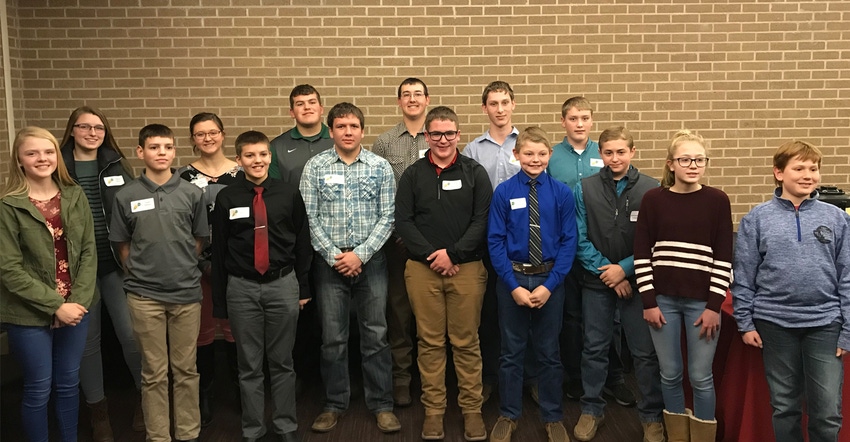
Brandy VanDeWalle calls it "on-farm research for youth." The Innovative Youth Corn Challenge, which recently completed its sixth year, introduces 4-H and FFA members to on-farm research, as well as potential science, technology, engineering and math careers.
Since the program started in 2012, 46 teams and 138 youth have participated, and 27 teams have successfully harvested and analyzed their plot data. The contest, open to 4-H or FFA members, guides participants through all aspects of corn production by testing different management practices and inputs on 1- to 2-acre plots and exposes youth to potential careers related to corn production.
VanDeWalle, Nebraska Extension educator in Fillmore and Clay counties, says the program has helped give participants a foundation in corn production and agronomy.
For 2018, Maple Creek Creators 4-H Club of Colfax County took first place. The team, which consisted of Korbin and Kara Kudera and was sponsored by Kevin Kudera, tested different in-furrow fertilizer treatments. They found no significant difference among treatments, and their control plot yielded 233 bushels per acre.
"They flagged the corn as it emerged to see the difference in emergence for different fertilizer treatments," VanDeWalle says. “The amount of work they put into it was amazing."
"Korbin Kudera, who was on the winning team this year, is going to the University of Nebraska and majoring in agronomy," she adds. "It's good to know he got a good foundation by learning about corn production through this program."
The Rising Stars 4-H Club from Platte County received second place. The team, which consisted of Kade and Isaac Stromberg and was sponsored by Brad Stephens, tested seeding rates of 30,000 and 33,000, with 27,000 seeds per acre as their check. In this case, the check treatment had the highest yield at 257.36 bushels per acre — and also was the economic optimum seeding rate.
Lost Creek 4-H Club from Colfax County received third place. The team consisted of Logan, Gavin and Rylan Nelson, and was sponsored by Steve Nelson. They tested Acceleron's Nemastrike corn seed treatment, a new product for nematode control. In this case, results showed both treatments had the same yield of 239 bushels per acre.
Also completing their plots were:
The Shelton FFA team, consisting of Jacob Snyder, Andrew Rayburn and adviser Hannah Horak, tested plant growth regulators, stimulants and biologicals, including Nachur’s SRN product. The study found a yield of 217.94 bushels per acre in the Nachur’s SRN treatment, compared with 217.16 bushels from the check treatment.
The Kornhusker Kids 4-H Club of Dodge County, consisting of Kaleb and Landon Hasenkamp, Matthew and James Rolf, Levi Schiller, Ian and Payton Schiller, and sponsored by Chris Schiller, worked with the University of Nebraska-Lincoln on an in-season nitrogen management program with four treatments — including prescriptions created by Climate Field View, UNL's Project SENSE, a grower-generated prescription, and a reference strip. Results showed the greatest return on investment from the grower-generated prescription with a yield of 213 bushels per acre.
"This year, we were able to generate some data for the Nebraska On-Farm Research Network, too," VanDeWalle says. “It's great to see kids contributing to the same work that farmers are. In this case, their own management outyielded the SENSE treatment."
The Fillmore Central FFA team, consisting of Brock and Carson Tatro, Jared Engle, Gunner Gewecke, Conner Nun, Kaylea Geiser and KayLynn Sieber, and sponsored by Kurt VanDeWalle, tested different seeding rates at 35,000 and 32,000 seeds per acre. The lower seeding rate of 32,000 seeds per acre yielded higher at 280 bushels per acre, compared with 229 bushels with 35,000 seeds per acre.
Golden Gate Clever Clovers 4-H Club, consisting of Aaron Fuchs and Brooke Hilgenkamp, sponsored by Michael Fuchs and Nathan Mueller, tested different seeding depths. In this case, a 2.75-inch seeding depth yielded 196.06 bushels per acre, and a 2-inch depth yielded 191.51 bushels per acre.
Other awards included:
• The Extra Mile Award, worth $200, went to Maple Creek 4-H Club.
• The Innovation Award, worth $200, was presented to the Kornhusker Kids 4-H Club.
• The Sustainability Award went to Kornhusker Kids 4-H Club. This $200 award uses the Field to Market tool to measure different components of sustainability in crop production.
"The biggest takeaway is for them to realize that there is a value from doing their own on-farm research, and to always test or verify whether different products will work for you on your field," Brandy VanDeWalle says. "With the lower commodity prices we're facing, aiming for the highest yield isn't always the most economical choice. If something results in just 2 or 3 more bushels, how much more does it actually cost to get those additional bushels?"
To participate in 2019, youth should register by March 15 at cropwatch.unl.edu/youth/cornchallenge. The program is made possible by financial support from the Nebraska Corn Board.
About the Author(s)
You May Also Like






